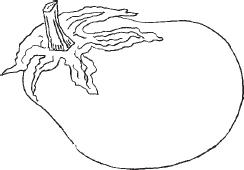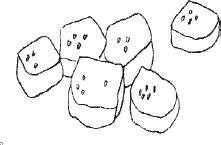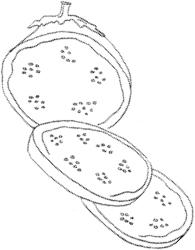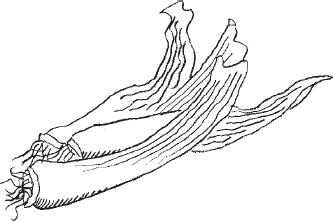Nourishing Traditions: The Cookbook That Challenges Politically Correct Nutrition and The... (107 page)
Authors: Sally Fallon,Pat Connolly,Phd. Mary G. Enig
Tags: #Non-Fiction, #Reference, #Science, #Health

Saute mustard seeds, fenugreek seeds, red pepper flakes and ginger in butter. Add onion and jalapeno peppers and saute until tender. Add turmeric and stir around. Add corn and garlic and mix well. Simmer gently until corn is just tender. Stir in yoghurt and season to taste. Garnish with chopped cilantro.
The evidence points to MSG sensitivity of epidemic proportions among the general population. But for most people the symptoms are vague: depression, headache, mild nausea, pressure around the eyes, tingling of the face, behavioral disturbances in children and mood swings, accentuating those already present in adolescents and also in adults. . .. Recently, we have witnessed important changes in personal habits. Families eat together less often. When they do sit down to a family meal, it often consists of convenience foods, such as fried chicken, frozen dinners, canned soups, vegetables in sauces and prepared salad mixes, all of which usually contain MSG. When you further consider that monosodium glutamate is an ingredient of seasoning salts, bouillon, hydrolyzed vegetable protein, meat tenderizers, most prepared spaghetti sauces, most sausages, some bacons and even such ethnic foods as gefilte fish and matzo balls, it becomes quite evident that the level of MSG in any family meal may be quite high. . .. MSG is a standard ingredient in most canned soups, soy sauces, bouillon cubes, soup stocks and frozen dinners. It is difficult to avoid even in the finest of restaurants. . .even the cigarette smoker may get additional MSG since tobacco leaves have been cured with MSG for smell and flavor enhancement. George R. Schwartz, MD
In Bad Taste: The MSG Syndrome

EGGPLANT
Eggplant contains a bitter juice that must be removed by salting. Peel the eggplant and cut into ½-inch cubes. Place in a bowl and toss with a generous spoonful of fine sea salt. Let stand, covered, about 1 hour. Rinse in a colander and pat cubes dry with paper towels or a tea towel. Use prepared eggplant cubes in the following recipes.
Broiled Eggplant Slices
Serves 6
Peel eggplants and slice lengthwise about
3
/
8
-inch thick. Sprinkle with salt and let stand 1 hour. Rinse and pat dry. Place on a well-oiled cookie sheet and brush half the marinade on top of slices. Broil until golden, turn, brush other side with remaining marinade and broil again.

Ratatouille
Serves 8
2 large eggplants
1 zucchini, cut lengthwise and thinly sliced
1 green pepper, seeded and cut into strips
2 onions, peeled and sliced
4 tomatoes, peeled, seeded and chopped
4 cloves garlic, peeled and mashed
1 teaspoon dried thyme
about ¾ cup extra virgin olive oil
There are two secrets to a good ratatouille: One is to saute all the vegetables separately; the second is to bake your casserole in a shallow open pan so that most of the liquid evaporates. Peel and cube eggplant and prepare according to master recipe (
Eggplant
). Saute eggplant cubes in batches in several tablespoons olive oil. Remove with a slotted spoon to an oiled rectangular pyrex baking dish. Saute zucchini, pepper, onions and tomatoes in succession, adding more olive oil as necessary and removing to casserole. (To peel tomatoes, see
Kitchen Tips & Hints
.) Add mashed garlic and thyme to casserole. Mix well and bake, uncovered, at 350 degrees for at least 1 hour. Ratatouille often tastes better reheated the next day.
Although the eggplant is associated with Mediterranean cooking, its original home is tropical Asia. Primitive forms in this part of the world were very small and were invariably eaten pickled. The European name for eggplant—
aubergine—is derived
rather circuitously from the Sanskrit
vatin-ganah
which means "antiwind vegetable."
Until the potato reached Europe from the New World, the eggplant was the principle starchy vegetable prepared in numerous ways, including fried like potatoes.
Eggplant contains carotenoids, B complex, particularly folic acid, vitamin C, potassium, phosphorus and calcium. It contains some protein and is a good source of fiber. Eggplant contains compounds called scopoletin and scoparone that block convulsions. African folk medicine values the eggplant to relieve nervous excitement and to counteract epilepsy. It is also taken as a natural contraceptive. In Korea, dried eggplant is used to treat a variety of illnesses, including measles, alcoholism and stomach cancer. SWF

Eggplant Curry
Serves 62 large eggplants
2 medium onions, peeled and chopped
1 teaspoon fenugreek seeds
1 tablespoon ground coriander
1 tablespoon ground cumin
1 teaspoon turmeric
¼ teaspoon cayenne pepper
1 teaspoon freshly grated ginger
4 tomatoes, peeled, seeded and chopped
¼ cup cilantro, chopped
about ½ cup extra virgin olive oil
To peel tomatoes, see
Kitchen Tips and Hints
. Peel and cube eggplant and prepare according to the master recipe (
Eggplant
). Saute eggplant cubes in batches in olive oil and transfer to a rectangular pyrex baking dish. Saute the onions and spices in olive oil until onions are tender. Add remaining ingredients to onions except chopped cilantro. Simmer a few minutes, stirring, until well mixed. Add to casserole and mix well. Bake, uncovered, at 350 degrees about 1 hour. Garnish with chopped cilantro.
Jerusalem artichokes or "sunchokes" are actually the root or tuber of a type of sunflower native to North America. They resemble ginger root, and their flavor has been compared to water chestnuts. They provide carotenes, B vitamins, potassium, calcium and magnesium and are an excellent source of iron.
European culinary writers at first greeted the sunchoke with enthusiasm but soon discovered that the vegetable—so easy to grow and store—had a drawback. They "cause a filthy, loathsome, stinking wind within the body," said the Englishman John Goodyer in 1617. The tuber can cause flatulence because about 50 percent of its dry weight is made up of inulin, a long-chain starch composed of fructose molecules. The human digestive system lacks enzymes to break down inulin into absorbable sugars.
Fortunately, inulin dissolves in hot water, so the vegetable must be eaten well cooked rather than raw. Lemon juice added to the cooking water will prevent the iron-rich flesh from turning black. The Indians of North America also roasted the Jerusalem artichokes in pits for as long as 48 hours, during which the flesh turns brown and jellylike and a sweet, distinctive flavor develops—a sign that the hard-to-decompose inulin has broken down into simple sugars. A long period of cold storage will also cause most of the inulin to be converted into fructose. Raw or slightly cooked Jerusalem artichokes have been recommended for diabetics because most of the starch is unavailable. Unfortunately, when undercooked these tubers can cause severe intestinal distress. But diabetics can still enjoy properly prepared Jerusalem artichokes by mixing them with plenty of butter or cream, so that absorption of simple sugars into the bloodstream occurs gradually. SWF
JERUSALEM ARTICHOKES
Peel tubers and plunge into boiling filtered water. Cook for about 15 minutes, adding some fresh lemon juice to the cooking water during the last 5 minutes. Drain in a colander. They may now be sliced and sauteed in butter and olive oil, or mashed with butter, freshly grated ginger, salt and pepper.
An alternate method is to place washed but unpeeled tubers in a clay pot. Add about ½ cup of filtered water to the pot, cover and bake at 200 degrees for about 6 hours, or until very tender. (They will turn quite black.) To serve, peel and mash with butter, salt and pepper.
KALE
Remove stems, wash well in filtered water, tear into pieces and place in a large covered pot. Place over a medium flame. When kale begins to simmer, reduce heat. Simmer about 8 minutes until leaves are wilted. Transfer to a strainer or colander and squeeze out liquid. Chop coarsely, place in a heated serving dish and toss with a generous pat of butter.
Kale is one of several dark green leafy vegetables of the cabbage family, related to collards and mustard greens. All of these greens provide calcium, iron and carotenoids in abundance, as well as many anticancer factors. Kale and related greens should always be eaten cooked—but not overcooked—so that the oxalic acid they contain is neutralized. Make an effort to buy organically grown kale. Dark green, leafy vegetables grown in nitrogen fertilized soils tend to concentrate nitrites, compounds that are transformed into carcinogenic nitrates and nitrosamines in the intestine. SWF

